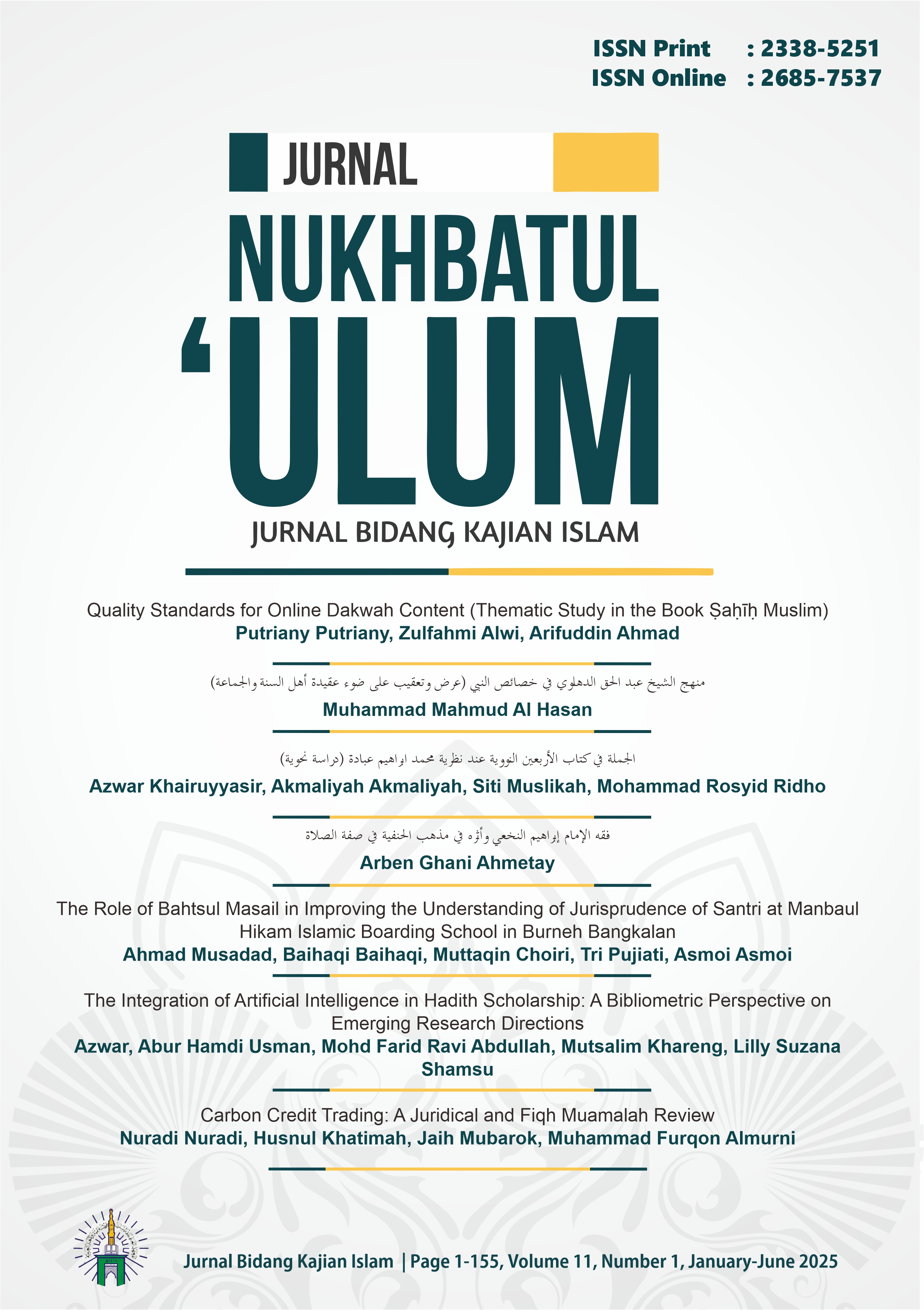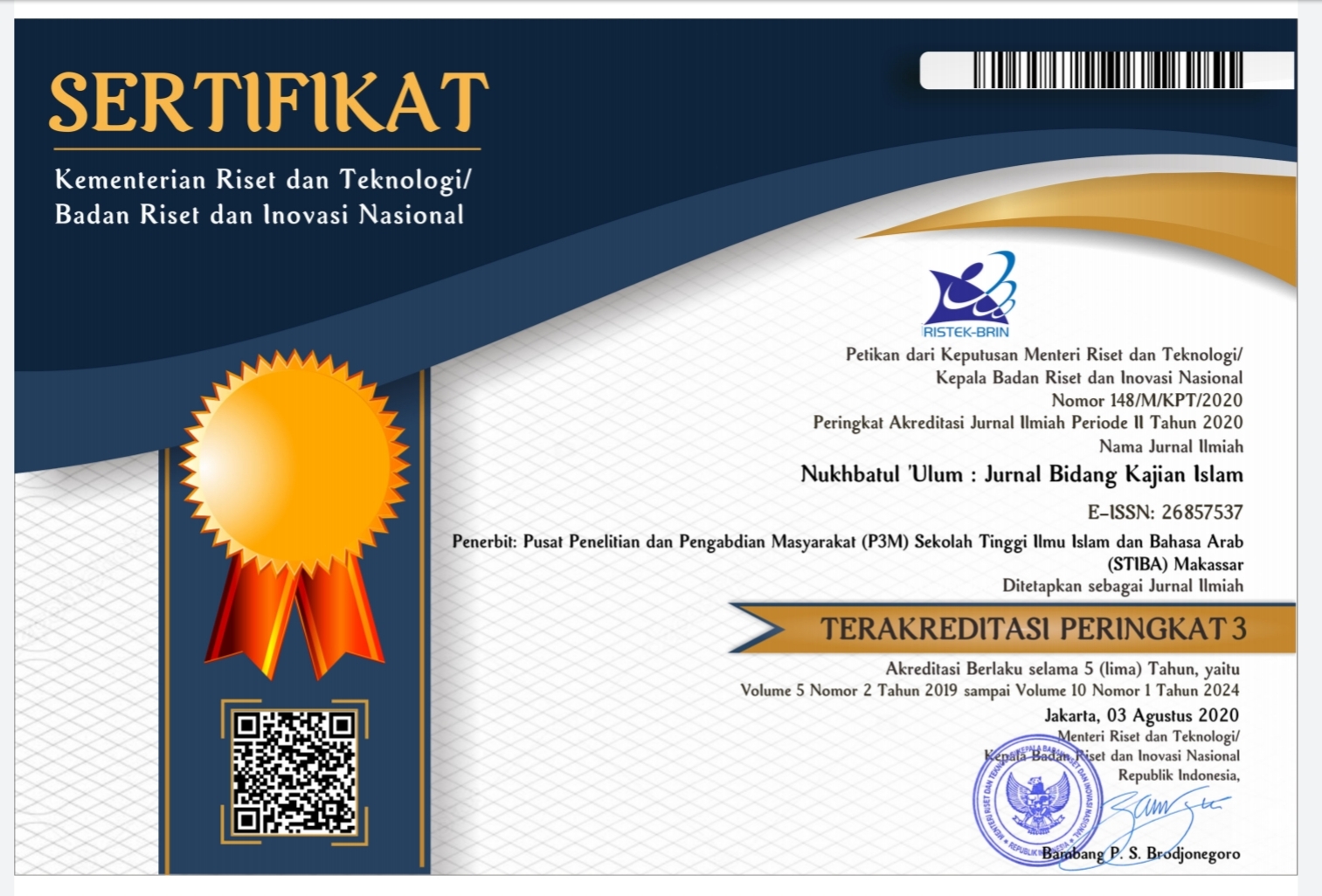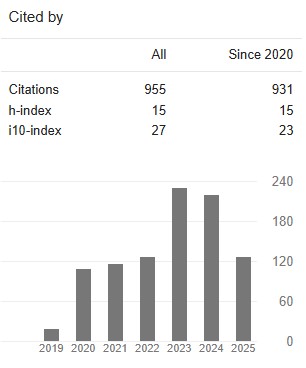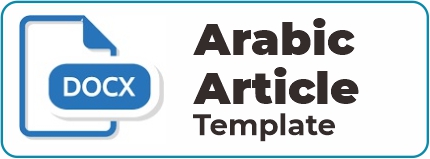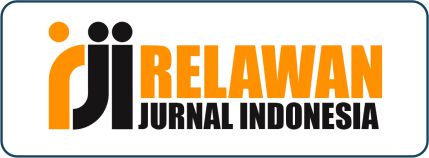The Integration of Artificial Intelligence in Hadith Scholarship: A Bibliometric Perspective on Emerging Research Directions
DOI:
https://doi.org/10.36701/nukhbah.v11i1.2251Keywords:
artificial intelligence; hadith; hadith studies; bibliometricAbstract
This study aims to map the research landscape concerning the role of artificial intelligence (AI) in hadith studies. It seeks to identify key academic trends, including publication growth patterns, frequently explored topics, institutional and individual contributions, emerging research directions, and areas that remain underexplored. The analysis employs bibliometric methods based on data from the Scopus database, covering the period from 2013 to 2024. The findings reveal a significant increase in scholarly interest, with 103 publications identified, reflecting the growing recognition of AI's relevance in hadith scholarship. Among the most prolific contributors is Sayoud, H., while the most cited work—Hadith Data Mining and Classification: A Comparative Analysis by Saloot M.A. et al. (2021)—highlights the multidisciplinary importance of AI in the classification of hadith. Publication analysis shows that the Journal of Theoretical and Applied Information Technology, Lecture Notes in Computer Science, and Procedia Computer Science are the leading platforms for disseminating AI-related research in this domain. Universiti Kebangsaan Malaysia stands out as the most active institution in this field. Geographically, Malaysia leads the research output, contributing 30 publications. Topic mapping identifies key research themes such as hadith, authenticity, narrator, Qur'an, model, approach, technique, and classifier. Emerging topics—including authenticity, narrator, reliability, isnad (chain of transmission), saying, and deep learning—indicate a growing focus on hadith authentication and chain analysis using AI technologies. Conversely, areas such as complexity, challenge, meaning, phase, order, Muslim, and legislation appear to be underrepresented, suggesting potential opportunities for future exploration. This study highlights the growing integration of AI into hadith scholarship, urging institutions to adopt digital approaches, expand research collaboration, and explore underrepresented topics through broader datasets and mixed-method analyses to advance both theoretical and practical dimensions of Islamic studies.
Downloads
References
Andriansyah, Yuli. “The Current Rise of Artificial Intelligence and Religious Studies: Some Reflections Based on ChatGPT.” Millah: Journal of Religious Studies, February 28, 2023, ix–xviii. doi:10.20885/millah.vol22.iss1.editorial.
Azmi, Aqil M., Abdulaziz O. Al-Qabbany, and Amir Hussain. “Computational and Natural Language Processing Based Studies of Hadith Literature: A Survey.” Artificial Intelligence Review 52, no. 2 (August 18, 2019): 1369–1414. doi:10.1007/s10462-019-09692-w.
Donthu, Naveen, Satish Kumar, Debmalya Mukherjee, Nitesh Pandey, and Weng Marc Lim. “How to Conduct a Bibliometric Analysis: An Overview and Guidelines.” Journal of Business Research 133 (2021): 285–96. doi:https://doi.org/10.1016/j.jbusres.2021.04.070.
Eck, Nees Jan Van, Ludo Waltman, Rommert Dekker, and Jan Van Den Berg. “A Comparison of Two Techniques for Bibliometric Mapping: Multidimensional Scaling and VOS.” Journal of the American Society for Information Science and Technology 61, no. 12 (2010): 2405–16. doi:https://doi.org/10.1002/asi.21421.
Farghaly, Ali, and Khaled Shaalan. “Arabic Natural Language Processing.” ACM Transactions on Asian Language Information Processing 8, no. 4 (December 2009): 1–22. doi:10.1145/1644879.1644881.
Hakak, Saqib, Amirrudin Kamsin, Wazir Zada Khan, Abubakar Zakari, Muhammad Imran, Khadher bin Ahmad, and Gulshan Amin Gilkar. “Digital Hadith Authentication: Recent Advances, Open Challenges, and Future Directions.” Transactions on Emerging Telecommunications Technologies 33, no. 6 (June 14, 2022). doi:10.1002/ett.3977.
Haque, Farhana, Anika Hossain Orthy, and Shahnewaz Siddique. “Hadith Authenticity Prediction Using Sentiment Analysis and Machine Learning.” In 2020 IEEE 14th International Conference on Application of Information and Communication Technologies (AICT), 1–6. IEEE, 2020. doi:10.1109/AICT50176.2020.9368569.
Hoque, Mesbahul, A Irwan Santeri Doll Kawaid, and Shumsudin Yabi. “Ethical Guidelines for the Use of AI in Hadith Studies.” In International Prophetic Conference (SWAN) FPQS USIM, 791–95, 2024. https://swanfpqs.usim.edu.my/index.php/conference/article/view/252.
Janiesch, Christian, Patrick Zschech, and Kai Heinrich. “Machine Learning and Deep Learning.” Electronic Markets 31, no. 3 (September 8, 2021): 685–95. doi:10.1007/s12525-021-00475-2.
Mukherjee, Debmalya, Weng Marc Lim, Satish Kumar, and Naveen Donthu. “Guidelines for Advancing Theory and Practice through Bibliometric Research.” Journal of Business Research 148 (2022): 101–15. doi:https://doi.org/10.1016/j.jbusres.2022.04.042.
Öztürk, Oğuzhan, Rıdvan Kocaman, and Dominik K Kanbach. “How to Design Bibliometric Research: An Overview and a Framework Proposal.” Review of Managerial Science, 2024, 1–29. doi:10.1007/s11846-024-00738-0.
Ridho Ilahi, Muhammad Barnaba, Fahrur Razi, Afif Maulana, and Babun Najib. “Hadith Critics Categories in The Selection of Hadith Narrators: A Comparative Analysis.” Jurnal Ilmiah Al-Mu’ashirah 20, no. 2 (July 31, 2023): 266. doi:10.22373/jim.v20i2.16787.
Sadiyah, Fatichatus. “Scientific Hadiths and Its Implementation in The Emergence of Artificial Intelligence (AI).” Dirosatuna: Journal of Islamic Studies 7, no. 1 (February 29, 2024): 1–15. doi:10.31538/dirosatuna.v6i2.4590.
Saloot, Mohammad Arshi, Norisma Idris, Rohana Mahmud, Salinah Ja’afar, Dirk Thorleuchter, and Abdullah Gani. “Hadith Data Mining and Classification: A Comparative Analysis.” Artificial Intelligence Review 46, no. 1 (June 8, 2016): 113–28. doi:10.1007/s10462-016-9458-x.
Sarker, Iqbal H. “Machine Learning: Algorithms, Real-World Applications and Research Directions.” SN Computer Science 2, no. 3 (May 22, 2021): 160. doi:10.1007/s42979-021-00592-x.
Taghian, Muhammad A. A. “Assessing the Accuracy Criteria of AI Tools-Aided Translation: A Case Study of Two-Word Prophetic Hadiths.” CDELT Occasional Papers in the Development of English Education 87, no. 1 (July 1, 2024): 217–62. doi:10.21608/opde.2024.384369.
Van-Eck, Nees Jan, and Ludo Waltman. “Software Survey: VOSviewer, a Computer Program for Bibliometric Mapping.” Scientometrics 84, no. 2 (2010): 523–38. doi:https://doi.org/10.1007/s11192-009-0146-3.
———. VOSviewer Manual: Manual for VOSviewer Version 1.6.18. Universitet Leiden & CWTS Meaningful Metrics, 2022. https://www.vosviewer.com/documentation/Manual_VOSviewer_1.6.18.pdf.
Xu, Yongjun, Xin Liu, Xin Cao, Changping Huang, Enke Liu, Sen Qian, Xingchen Liu, et al. “Artificial Intelligence: A Powerful Paradigm for Scientific Research.” The Innovation 2, no. 4 (November 2021): 100179. doi:10.1016/j.xinn.2021.100179.
Downloads
Published
Issue
Section
License
Copyright (c) 2025 Azwar Azwar, Abur Hamdi Usman, Mohd Farid Ravi Abdullah

This work is licensed under a Creative Commons Attribution-NonCommercial-ShareAlike 4.0 International License.

